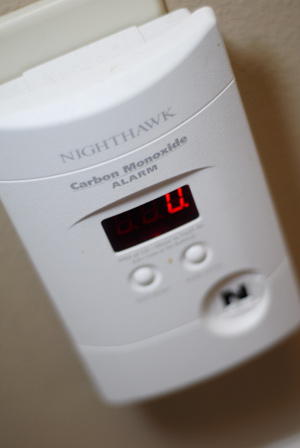What is Carbon Monoxide?
It is a tasteless, odorless, and colorless gas that is produced from incomplete burning of any type of fuel such as gas, oil, kerosene, wood, or charcoal.
What happens if you breathe Carbon Monoxide?
Carbon monoxide binds with hemoglobin and is carried to your vital organs and tissues which cause damage and eventual death to you if you are not treated immediately. You may have a high dose of exposure or a slow exposure.

What are the symptoms of Carbon Monoxide poisoning, and the danger of Carbon monoxide poisoning?
- Headache
- Dizziness
- Nausea **Danger** of this poisoning is if you are exposed at night or during sleep you may not have symptoms and death can occur in minutes.
What are the symptoms of carbon monoxide poisoning if you have exposure over a long period of time?
The same as quick exposure but over time you can have lasting heart and brain damage. You may feel nausea, headache, dizziness, shortness of breath, and some symptoms may disappear or lessen when you leave the small amounts of exposure then return when you go back to the place where the source is present.
What are some common sources of Carbon Monoxide poisoning?
- Fireplaces – they may become blocked. Always have inspected prior to use
- Powerboats
- Cars, trucks or other engines that are left on in the garage or small contained area
- Fuel-burning appliances that may not be installed properly or used properly
- Fuel-burning heating appliances that are used in cold weather when your windows and doors are always shut and well sealed. Always have appliances maintained and inspected prior to each use each season.
What are some carbon monoxide poison prevention steps?
Install, by manufacturers recommendations or by a professional, a certified carbon monoxide detector in your home in several areas. Each level of your home should have one installed and near each or several bedrooms. Each detector should be installed at least 15feet away from a gas appliance or heating source and may need to slightly higher than a few feet above the ground or at counter level. Carbon monoxide is known to be close to the weight of air and may rise with warm air. Check batteries regularly or have installed them with your alarm system. Check the operating device regularly if the testing button present. Read all guidelines in your manufacturer’s warranty or manual.
Be aware of the symptoms of carbon monoxide poisoning and evacuate your home immediately if you think you have a gas leak or suspect any leak from a gas appliance. If you suspect a gas leak in your home do not use the telephone because this could ignite a spark and cause an explosion; you may use your cellular phone but should evacuate immediately.
Go to your closest hospital or physician immediately if you suspect you have carbon monoxide poisoning.
Use fans at home especially when you are sleeping due to some evidence of decreasing carbon monoxide poisoning during sleep if it is present in your home.